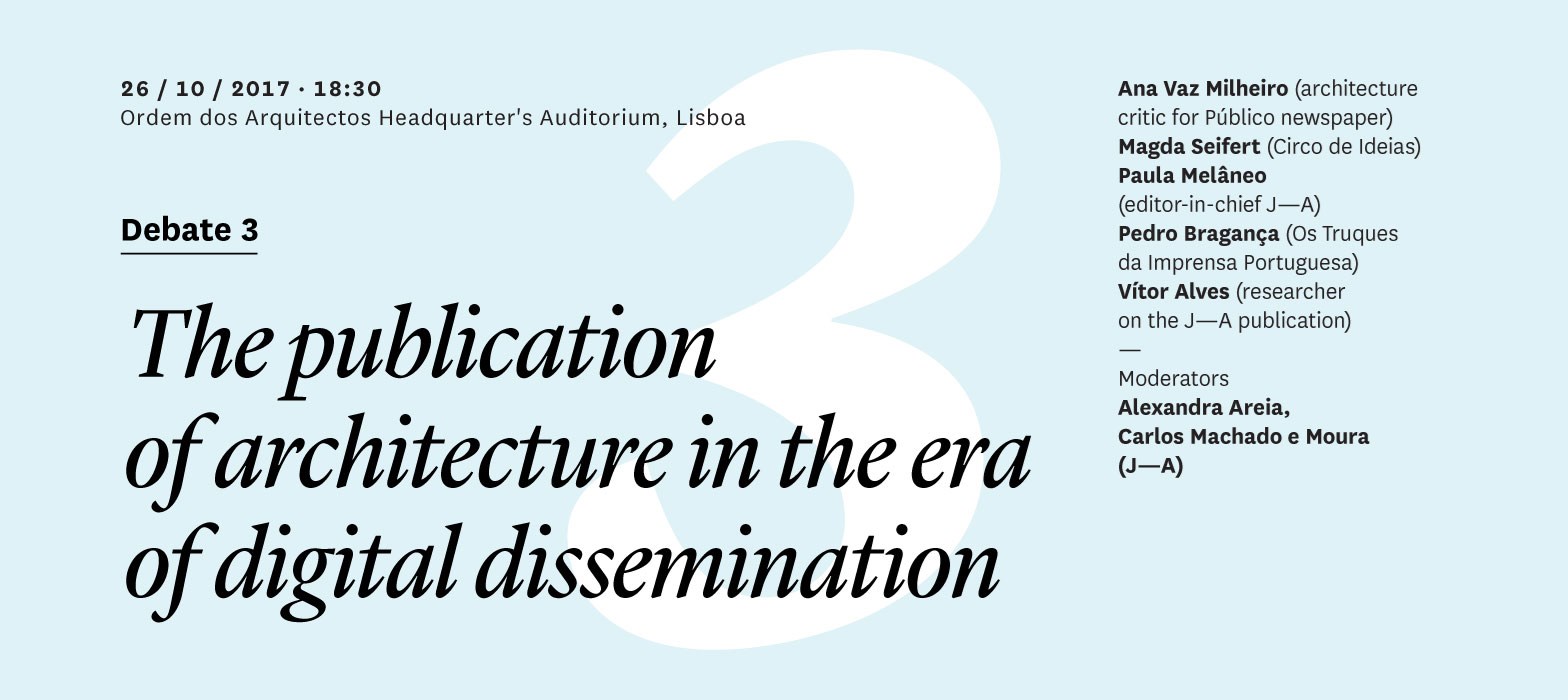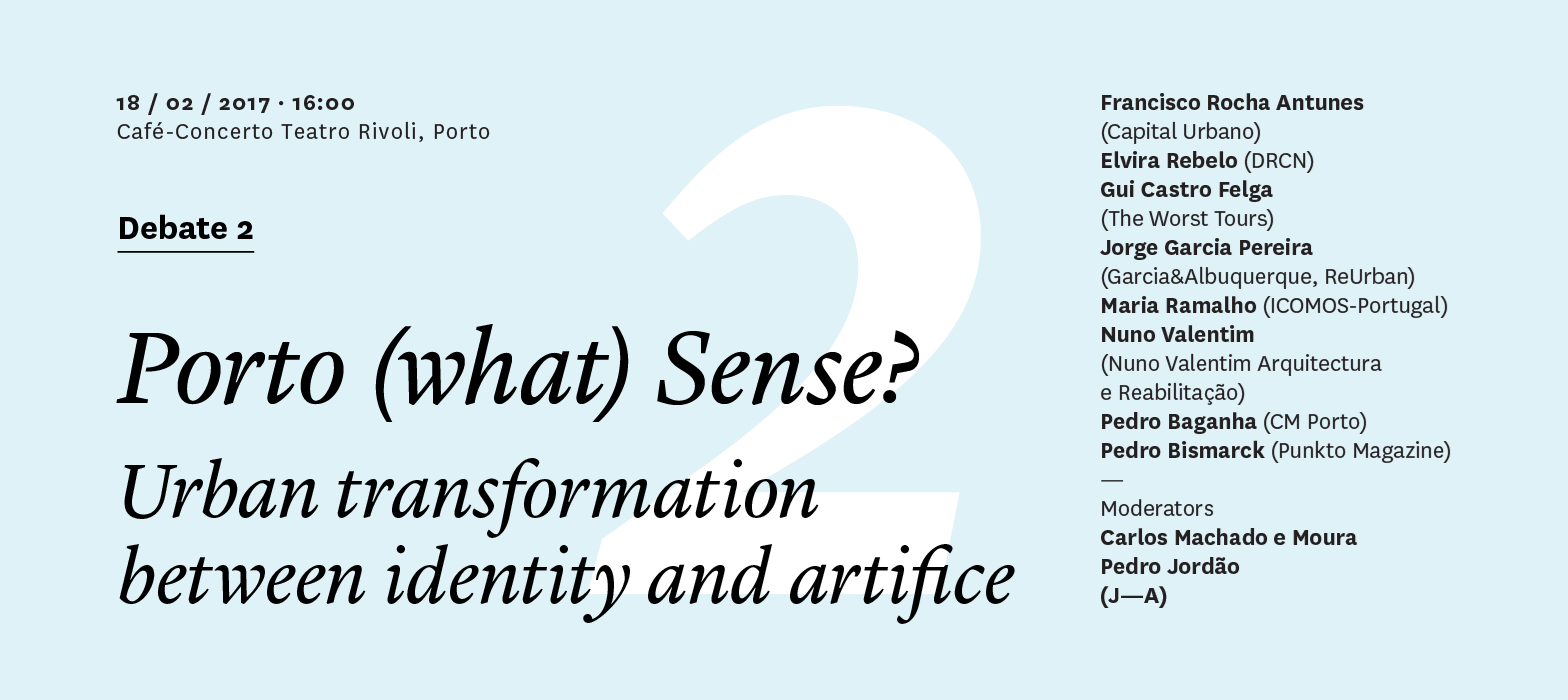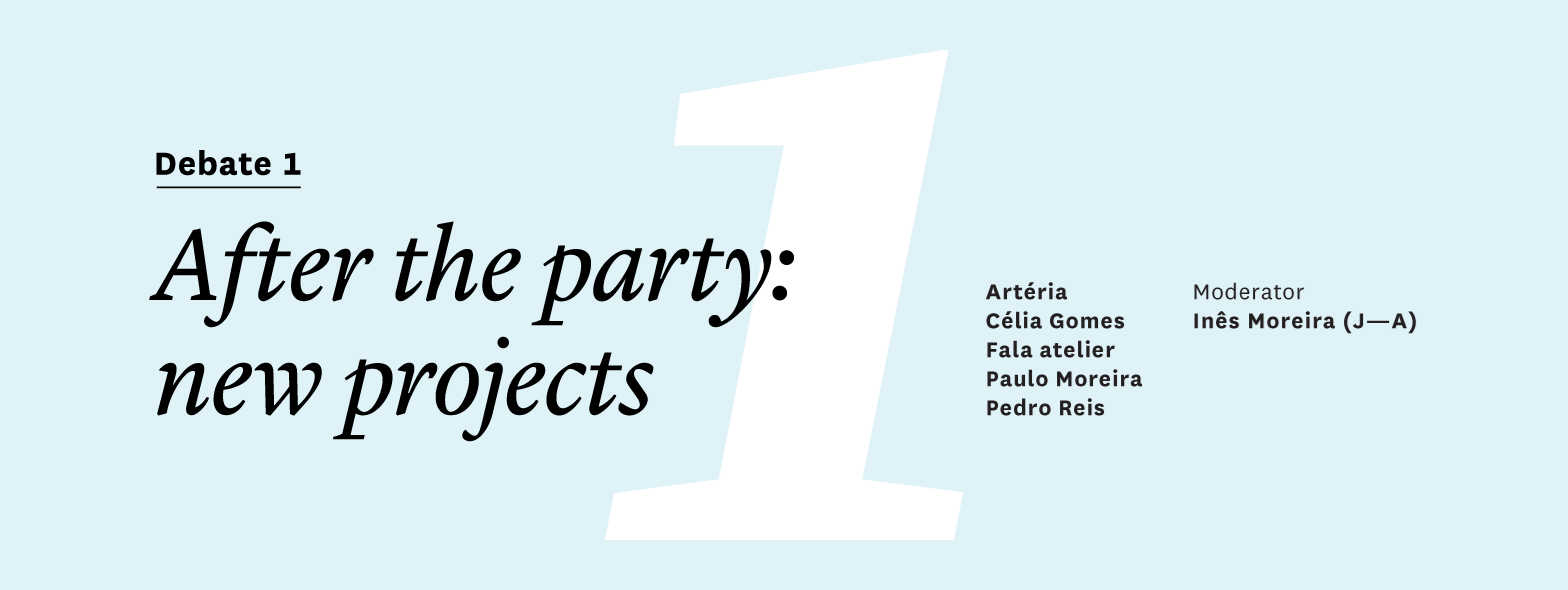
Report on the debate 3
By Alexandra Areia and Carlos Machado e Moura
J—A was preparing to resume their regular printed edition when, after three issues published in online format, this debate sought to generate a discussion on the formats of architectural publications at the present moment, among the new possibilities offered by the screen and the permanence of paper. This meeting also comes precisely three years after another, which was held on the occasion of the launch of the 250th issue of "J—A quarter of a thousand", which brought together members of the newspaper's different editorial teams before transitioning to an eminently exclusive digital edition.
On one hand, the conversation questioned the changes in the way we nowadays publish, read and access information, caused by the coexistence of digital and print media and also by the role of websites, blogs and social networks. On the other hand, it aspired to question the role and vocation of J—A – a corporate newspaper of a professional association with an important legacy at the level of critique and thinking, in architecture, in our country – in the two complementary dimensions in the exercise of architecture: of theoretical-critical reflection and of disciplinary practice.
Paula Melâneo – J—A's editor-in-chief for the 2016-2019 triennium – started by outlining the main guidelines of the current editorial project, inscribing it in the journalistic ethos of the previous series, and explaining the constraints related to the available budget and the particularities of the digital format. Questioned about the difference in reception of digital and print media, the democratic potential and the effects of "distracted consumption" discussed by Benjamin and Adorno, Magda Seifert – founder and in charge of the cultural association, bookstore and publisher Circo de Ideias – underlined the difference in materiality and, especially, the more attentive edition of the printed formats when compared to the online content, which opposed the long predicted death of the book.
Transposing the debate to the general press, Pedro Bragança – researcher and one of the authors of the website Truques da Imprensa Portuguesa – explained the main reasons for the crisis of the business model used in the traditional press and emphasised the different timing of publications, between digital's immediacy and the elongated time for publishing on paper. He also questioned the sustainability of business models supported by advertising, contrary to the myth that a printed publication is more expensive than an online edition. Vítor Alves – a researcher who has been conducting a study on the history of J—A between 1981-2015 – drew the evolution of the magazine and the vocation of the various series, reflecting on J—A's exceptional character in the landscape of architectural press of professional associations and discussing the relevance of publishing projects to the myriad of platforms currently in existence.
Ana Vaz Milheiro – lecturer, researcher and critic of architecture for the Portuguese newspaper Público –, drawing on her long experience in two J—A series (2000-05 and 2009-13), questioned the possibility of reconciling the production of original knowledge with the speed of digital dissemination. Establishing an underlying difference between digital and print editorial projects, she distinguished the option of simply making print content available online in contrast with the construction of a specifically digital product, with its own formats and contents, more oriented towards fast reading. It also recognised the progressive sophistication of online publications contrasting with a downscaling trend (and resources) of print editions and the consequent proliferation of smaller publishers.
The discussion continued on a number of complementary topics. These ranged from the place and potential of the moving image – at a time when video is gaining ground over photography, although it may not yet have attained autonomy in relation to the design that writing has been able to achieve – of the role played by digital platforms – not only in the circulation of ideas, images and projects, but also in a self-promotional mediatisation and awards fulfilled by populist criteria – to the function of architectural critique in the present and in the field of possibilities for the construction of oppositions. ◊

Report on the debate 2
by Alexandra Areia
The organization of the debate about the rapidly growing urban transformations occurring in Porto’s city centre stems from the conviction that these questions need to be broadly addressed and discussed, especially by architects. However, this could never be a strictly disciplinary debate – it would not be possible to understand the role of architects in the current process of urban regeneration without including the other elements involved and encompassing the broad diversity of points of view. As predicted, the debate was heated, yet among the many disagreements and oppositions, opinions were clarified and some consensus was reached. It was discovered that many of the phenomena that currently affect life in Porto’s city centre originate from deficiencies and fissures in Portuguese legislation, making the exertion of pressure on the central political power a priority. Yet, it was also defined that there is a certain failing of public institutions and an increasing loss of their representation as regulatory agents for the transformation of cities. The debate also focussed on the importance of active citizenship and an increasing participation in public discussion forums and project plans. However, it also became evident that the mechanisms available for this are far from being efficiently functional and that people feel that even when they participate, they are not really heard. The need to move forward with concrete measures that can be quickly put into action was also approached, leading to the conclusion that the diagnosis is far from being complete and that many more debates would be needed to understand the full complexity of the problem. And as for the role of architects in these questions, the debate clarified that there is an effective lack of adherence to public discussion forums and an absence of responsibility in the preservation of currently non-classified patrimony, ending with the affirmation of the non-existence of a public dimension of architecture – a discipline that is becoming increasingly “privatized”.
Jornal Arquitectos (J—A)
Ordem dos Arquitectos
Alexandra Areia, Carlos Machado e Moura, Pedro Jordão


Report on the debate 1
By Fabrícia Valente
After the party: new projects is the first debate organized by the current J—A editorial team, following the edition dedicated to the theme National Representations. After an issue focussing on three great international exhibitions – Venice Architecture Biennale, Milan Triennale and the Les Universalistes exhibition by the Paris Delegation of the Calouste Gulbenkian Foundation – this debate is a moment dedicated to understanding the more or less direct consequences that these international exhibitions can have on the work of architects. To talk about architectural debate and criticism today is to also talk about temporary exhibition spaces, especially the ones that have fixed periodicities, such as international biennales and triennales. After the party questions if visibility results from these events and if professionals are offered project commissions as a result of that visibility. After the participation, what kinds of invitations are extended, if any? Is there a linear reading of the before and after of the work of the represented parties? The answer is not simple and many times some temporal distance is necessary to understand its real reverberations.
Drawing on extremely different experiences and aiming for a plurality of responses, J—A brought together five architects/ateliers: Célia Gomes, Pedro Reis, Fala Atelier, Paulo Moreira and Artéria Arquitectura, moderated by Inês Moreria, to present their points of view ranging from ideas on atelier evolution, to looking at projects and representations in which they participated.
The consequences of participating in international exhibitions seem to vary according to different practices and exhibition processes. In the case of the ateliers, it brings the fruition of projects as well as new research and procedural challenges, deconstructing classic learning methodologies of architecture. Inês Moreira talked about the growth of architects through the practice of building construction as well as other “deviating” – or not – experiences of their careers, causing the speakers to question their positioning within architectural practice. The debate affirmed the importance of the bipolarity of architecture between practice and theory, and made evident the role of the exhibitions in attaining international visibility, while also demonstrating some difficulty in understanding what is or is not a cause and a consequence. It is perhaps in this fluidity of events that the real gain is achieved, offering a different dimension to the “party”, with different velocities according to the different generations here presented, in a mediatisation of architecture based on an analogue visibility versus the current constant supply of images and information about content that is disciplinarily specific but also easily accessible to all. Representation events are increasingly translated into experiences that stray from what until now was understood as an exhibition, a building construction or a workshop, and often also translated into alternative projects, where representations also question these frontiers, provoking the loss of perception of all the participants and actions before, during and after the party.